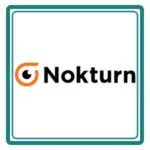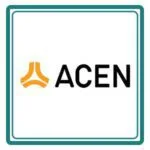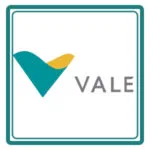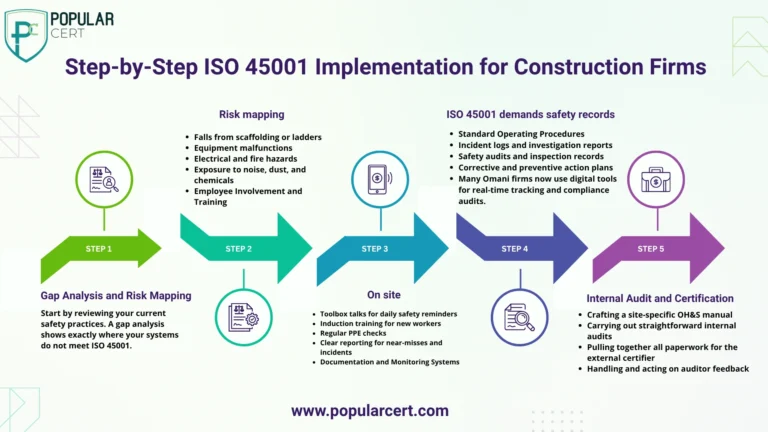ISO 45001 in Oman’s Construction Sector: Safer Workplaces, Stronger Compliance

In Oman’s booming construction scene, keeping people safe has moved from being a nice-to-have to something every project simply cannot afford to ignore. Tight deadlines, searing heat, and the sheer complexity of building on a busy site mean that basic safety rules no longer cut it; firms really need a tougher plan if they want to protect their crews and keep work on track.
That’s where ISO 45001 Certification, the global benchmark for workplace health and safety, comes in. By following its steps, contractors here can spot hazards before they hurt someone, stay on the right side of the law, and even win more bids because clients notice the extra care.
So whether you run a small crew or oversee a major development, now is the moment to lean into ISO 45001 and turn good intentions into safer job sites across Oman.
What Is ISO 45001 and How It Differs from OHSAS 18001
Evolution from OHSAS to ISO 45001
When ISO 45001 appeared in 2018, it took the place of OHSAS 18001 and gave safety management systems a fresh, modern upgrade. Whereas OHSAS leaned heavily on written procedures, the newer standard steers organizations toward identifying risks and viewing safety as a core process, much like how ISO 9001 handles quality and ISO 14001 tackles environmental issues.
That shift makes it easier for companies to weave safety into everyday work and to create a caring, proactive culture instead of simply cleaning up after accidents.
ISO 45001 Core Principles
- Worker Participation: Employees are empowered to report hazards and suggest improvements.
- Leadership Commitment: Management takes active ownership of the OH&S system.
- Hazard Identification: Systematic mapping of risks across all activities.
- Continuous Improvement: Use of audits, feedback, and performance data to enhance safety practices.
Why Construction Companies in Oman Need ISO 45001
1.Industry Risks and Compliance Needs
Oman-s construction sites present tough hazards: scaffoldings way up high, earthmovers rumbling close, and crews sweating under blistering sun. In that setting, ISO 45001 acts as a clear, step-by-step safety guard.
The Labour Ministry and other watchdogs now demand firms use up-to-date safety plans, not yesterday-s checklist. Fail to do so and the penalties can include:
- pausing work until fixes show up
- expensive court fines
- soaring insurance bills
- bad headlines that linger
To keep projects moving and minds calm, contractors across Oman need to adopt ISO 45001 and turn risk spotting from a post-accident task into an everyday habit.
2. Competitive Advantage and Tender Eligibility
Big public and private builds-housing clusters, water plants, even solar parks-often require bidders to prove their safety system is more than paper, preferably certified.
These jobs regularly list ISO 45001 as a gatekeeper question. By earning the badge a firm also:
- gains trust from ministries and major clients
- boosts the odds of landing scarce contracts
- shows workers their safety really counts
In a crowded market the standard stops being just red tape and becomes a real pull for growth.
Step-by-Step ISO 45001 Implementation for Construction Firms
Types Of Certification
- ISO Certification
- ISO 9001 Certification
- ISO 14001 Certification
- ISO 45001 Certification
- ISO 22000 Certification
- ISO 27001 Certification
- ISO 17025 Certification
- ISO 13485 Certification
- ISO 20000-1 Certification
- ISO 22301 Certification
- ISO 50001 Certification
- ISO 37001 Certification
- IATF 16949 Certification
- ISO 29001 Certification
- ISO 31000 Certification
- ISO 20121 Certification
- ISO 10002 Certification
- ISO 41001 Certification
Get Free Consultation
Our Clients



















Key Benefits of ISO 45001 Certification
1. Tangible Safety Improvements
Construction firms already carrying the ISO 45001 badge have noticed clear, trackable gains:
- Fewer lost-time injuries
- Quicker, more effective incident responses
- More workers flagging and fixing hazards
- Safer sites that boost team spirit
For any contractor keen to cut incidents and trim costs, adopting ISO 45001 in Oman is a smart step that pays off fast.
2. Business and Legal Advantages
On the business side, the standard delivers:
- Lower chance of lawsuits and big compensation payouts
- Simpler alignment with Oman’s labour and safety rules
- Better staff retention; people trust certified employers
- Tighter, healthier risk profiles that bring insurance discounts.
Why Choose Popularcert for ISO 45001 in Oman?
Popularcert is a respected ISO-certification and consultancy firm that helps Omani construction companies build and certify effective safety-management systems. Drawing on years of local experience, we provide:
- a tailored gap analysis for each project site,
- auditors who know Oman’s labour laws and site hazards,
- actionable training sessions and ready-to-use document templates,
- step-by-step support from the kickoff meeting to the final certificate-no off-the-shelf fixes,
- an express certification option when tender deadlines are tight.
Because we work on-site with your team, our clients report that they do not just gain a plaque; they gain safer jobs and lower incident rates. If you want those real results from ISO 45001 in Oman, come talk to us.
Call Popularcert now for a no-cost consultation and a quick safety check of your site.
Conclusion
Oman’s construction boom is impressive, but so are the growing safety demands from regulators, workers, and clients. ISO 45001 Certification is therefore more than a badge on the wall; it is insurance for your crew, your brand, and tomorrow’s contracts.
Whether you are launching your safety program or upgrading from OHSAS 18001, the moment to move forward is right now. Fortify your operations with ISO 45001 and stay ahead of the competition.
Popularcert will guide you through the gap analysis, the audits, and every step afterward. Reach out today for your complimentary safety-readiness review.
GET A FREE CONSULTATION NOW
FAQs
Is ISO 45001 mandatory in Oman's construction industry?
It’s not yet a blanket legal requirement across all firms, but many major clients-including government projects-insist on the standard when they draft tender papers. Adopting it now keeps you in the game.
How long does it take to get ISO 45001 certified?
The reliable time frame sits between four and twelve weeks, with speed tied to your firm’s size and how well it already meets the standard. Popularcert can shorten that span by offering clear steps and quick audits.
What documents are required for ISO 45001 certification?
At a minimum you will need a health-and-safety policy, records of risk assessments, training logs, written procedures, internal-audit notes, and files on any incidents. Popularcert also hands out ready-made templates and ongoing coaching.
Can small construction firms also benefit from ISO 45001?
Definitely. Smaller businesses see fewer accidents, keep staff around longer, and find it easier to bid on public jobs or team up with larger firms. Best of all, the standard scales-up or down-to fit your company’s size.
How does ISO 45001 differ from OHSAS 18001?
While OHSAS 18001 worked in its own lane, ISO 45001 pushes a wider, preventive view, expects leaders to set the tone, and meshes neatly with other ISO systems.
